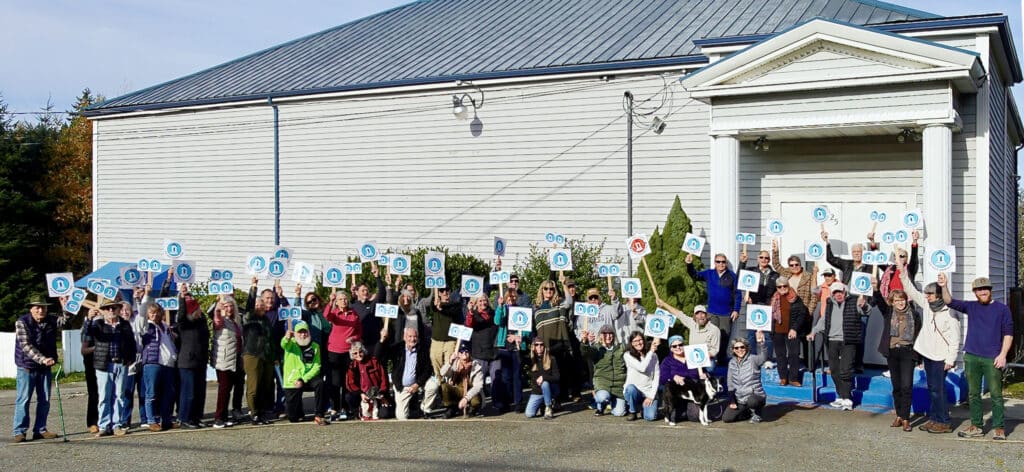Community Government
Historic Preservation Commission wants city to tap the brakes on Masonic Lodge
In a reversal of its decision in early September, the Gig Harbor Historic Preservation Commission unanimously voted on Nov. 10 to recommend that the city hold off on demolishing the former Masonic Lodge. The commission also suggested contracting with a surveyor for an historic structures report before the city makes any decisions.
The commission voted to support preserving the lodge in some form as part of the city’s Crescent Creek Park redesign, after hearing from several members of the public, three of whom gave a co-presentation during the public comment period. Several commission members also voiced strong support for the lodge, before the vote.
‘No historic value’ is a mischaracterization
Lita Dawn Stanton, John McMillan and Mary Manning spoke on behalf of lodge preservation supporters.
Stanton — who served as the city’s historic preservation officer for more than eight years — noted several places around Gig Harbor, including the Skansie Brothers Netshed and Wilkinson Farm, that serve as historical preservation success stories.
Importantly, the lodge is listed on a 2008 register of city-owned historic landmarks, “yet the Parks Commission was told that the lodge has ‘no historic value,’” Stanton said.
That characterization, she continued, comes from a 2023 Rolluda Architects technical memo. The memo states that “the lodge is ineligible for a national register listing.”

Masonic Lodge supporters held a rally in front of the building on Sunday,, Nov. 9. Photo by Jan Hein
The commission noted at its meeting in September that the city’s architect had deemed the building too altered from its original form and function as a schoolhouse to be considered historic.
But this doesn’t mean that the lodge is ineligible for other historical listings. Stanton briefly outlined the criteria to designate an historic landmark, from most to least stringent. The National Register is the most stringent, whereas Gig Harbor’s Historic Register Sites is voluntary and carries no regulatory requirements.
“The fact is, there is no historic structures report [about the lodge], so no one can claim anything about its eligibility,” Stanton said. “The only other credible historic preservation input that I read is from a 2023 letter from Washington State Department of Archaeology and Historic Preservation … that says, ‘If the community sees it as a historic landmark, then it has value.’”
“The point is,” she continued, “whether the lodge is listed or not doesn’t matter. If this community values the lodge as an important Gig Harbor landmark, then it should not be demolished. I can’t help but wonder if the parks commission had adequate, accurate information.”
Lack of communication
Manning raised concerns about what is being communicated to the Historic Preservation Commission.
“I do have some questions, like how is it that this is the first time this is coming to the Historic Preservation Commission when the property itself has historic value?” Manning said. “When I spoke to the consultant on-site, she was well aware that the Masonic [Lodge] had historic value.”
Manning served on the city’s Design Review Board for seven years. Part of the board’s job involves handling historic preservation. Manning said she remembers reviewing the lodge, so “the city was well aware that we had that knowledge.”
The commission, she continued, should already have had all the information that she, Stanton, and McMillan presented that evening. Manning expressed concern over the “functioning of the commission itself” and why, from her perspective, the city had not included the commission early on in the process of debating the lodge’s preservation or destruction.
Manning also noted that the city’s inventory of historic structures has not been updated since 2008. She acknowledged that this has to do with budget constraints, but also said that this was part of the commission’s advocacy work.
“You cannot consider historic structures without considering their use,” she said. “Both as a school and as a Masonic Center, we’ve always had a communal function and the city still desperately needs that.”
Gig Harbor’s historic preservation code
The city has its own historic preservation code, explained Community Development Director Eric Baker. For a building to qualify for the historic register, it must be associated with some sort of significant aspect of Gig Harbor, remain structurally sound, and fall into one of 11 categories listed in the code. If the building is younger than 50 years old, it must hold “exceptional importance.”
One issue with the Masonic Lodge is its current physical state, Baker said. In addition to “certain levels of asbestos” and lead contamination, he said, its foundation is cracked and it needs seismic upgrades. Mold is also in the building, due to a combination of the cracked foundation and limited insulation.
He also said the city must consider the building as it stands for historic preservation, not how it may be altered. This includes the one-floor lodge proposal McMillan submitted for consideration that the commission touched on at its last meeting. Any upgrades or renovations — even historic ones — would follow a separate code, and would require a Certificate of Appropriateness.
Certificate of Appropriateness
There are several restrictions on what may be done if an historic property is to receive a Certificate of Appropriateness, Baker noted. He read off several criteria listed in the city code, including that the historic character should be retained and preserved, that any renovations must avoid altering removing historic materials, and altering features and spaces that define the building. Because the lodge would need significant renovation for safe use, it will also require this certificate.
“It would need to be reviewed by this body and any of the proposed changes would need to meet each of these criteria,” Baker said. “You have to meet each and every one of them in a proposed revision. … We have a little more latitude, if you’re talking about additions, but the actual footprint of the existing building has some very, very tight standards on how you can update it, how you can do a number of other things. So again, … it establishes additional criteria that can affect the viability of upgrades, but also the cost of upgrades if you’re working around things.”
Cost discrepancy
Cost was one of the primary factors the lodge’s detractors cited at a late September open house about the Crescent Creek Park redesign. The city also highlighted the estimated $4.5 million cost to restore the lodge in its initial survey materials. Lodge supporters said that they felt this was an unfair presentation, given that the $4.5 million was the only cost presented to survey takers at the time.
Baker said that while the City Council will consider the Parks Commission’s recommendation at its Nov. 20 meeting, it will also consider feedback from the community at large, including the Youth Council, which recommended against keeping the lodge.
He later noted that he would tell the council that “[t]he Historic Preservation Commission really should have been folded in a lot earlier and would like to see at minimum that information from the historic survey available prior to a final decision by the council on its future.”
Commission thoughts
Historic Preservation Commission member Guy Hoppen advocated for another survey. He noted that before the city formed the commission, he asked it to do another historic structure survey. Since then, he said, he has done so several times.
Like Manning, Hoppen felt that the Parks Commission and the Youth Council were not “armed with enough information, and to provide that information, that survey needs to be accomplished.”
Deciding anything before completing that new survey, he said, would be “putting the cart before the horse.”
He also said that an official from the Department of Archeology and Historic Preservation (DAHP) told parks staff in an email that “evaluating the lodge for local landmarking eligibility is the best way to guide the commission’s decision.”
“We suggest engaging your architectural historian to evaluate the building’s historic significance as a Masonic lodge to produce a report for the commission and community to consider in deciding the future of the building,’” Hoppen said, reading off the DAHP official’s email. “That’s a roadmap for us to take.”
He also noted that he went through the documents prior to the meeting, and that though there is indeed a leak in the foundation, “the roof elements, including rafters, trusses, beams, are in acceptable condition,” and that “the second floor elements of the historic structure … ‘are in good condition.’”
Hoppen added that just two of 25 suspected asbestos-containing materials actually had asbestos and that 13 of 78 locations had lead paint. Almost all of those locations were things like railings, door jams, or doors that could be removed and replaced without mitigation.
“As I read it, the condition of the building’s not nearly as dire as [it has been made out to be],” Hoppen said. “It’s pretty minor from these documents.”
Local Masons
Commissioner Stephanie Lile, who also serves as the Harbor History Museum’s director, highlighted that Masons were active in the community even before local Rotary Clubs and other community service organizations.
“These were movers and shakers in this community,” Lile said. “And we can’t ignore the fact that they made history just by being part of that organization and being part of that building. So I feel strongly that it absolutely is eligible for an Historic Register, whichever one we decide is the appropriate one to go for.”
Lile, who also served on a grassroots committee to come up with a proposal to save the lodge, highlighted that the $4.5 million figure for lodge restoration is not entirely accurate, because it was the top end of an estimate from Washington Patriot Construction, a local general contractor that volunteered to help the committee.
Making it ADA accessible as-is would cost about $1.5 million, she said. However, to make it “extra-usable and still retain the historic character and the historic footprint” would require an addition with new plumbing, exterior restrooms for the park, and interior restrooms for the main floor of the building and the catering kitchen. This is where the $4.5 million came from.
“So, could you do it for less and not have an addition on the back for restrooms and that sort of thing? Yes, you could,” she said. “But if you really wanted to make it as usable as possible, that’s probably your best option to retain the historical print as well as cater to all of the needs that we have as a growing community in terms of restrooms and all that.”
She said that the entire estimate is important for the council to consider.
Personal connection
Fighting back tears, Commissioner Gina Brais voiced her support for the lodge, as she recalled its link with her grandparents.
“My maternal grandmother and father built a house on the east side of Gig Harbor,” Brais said. “I’m a kid from California. And since 1984, I’ve come here every single year of my life … and every single year I’d come here, my grandmother drew a map out … of how to get to her house in Gig Harbor. And I always knew that I was home — and I call home my grandparents’ home — the second I saw this lodge. This is when I knew I was home.”
In taking the vote, Commissioner Jon Ashlock said the commission would recommend to council not to demolish the lodge, but to get more information through an impartial surveyor to create an historical structures report.

